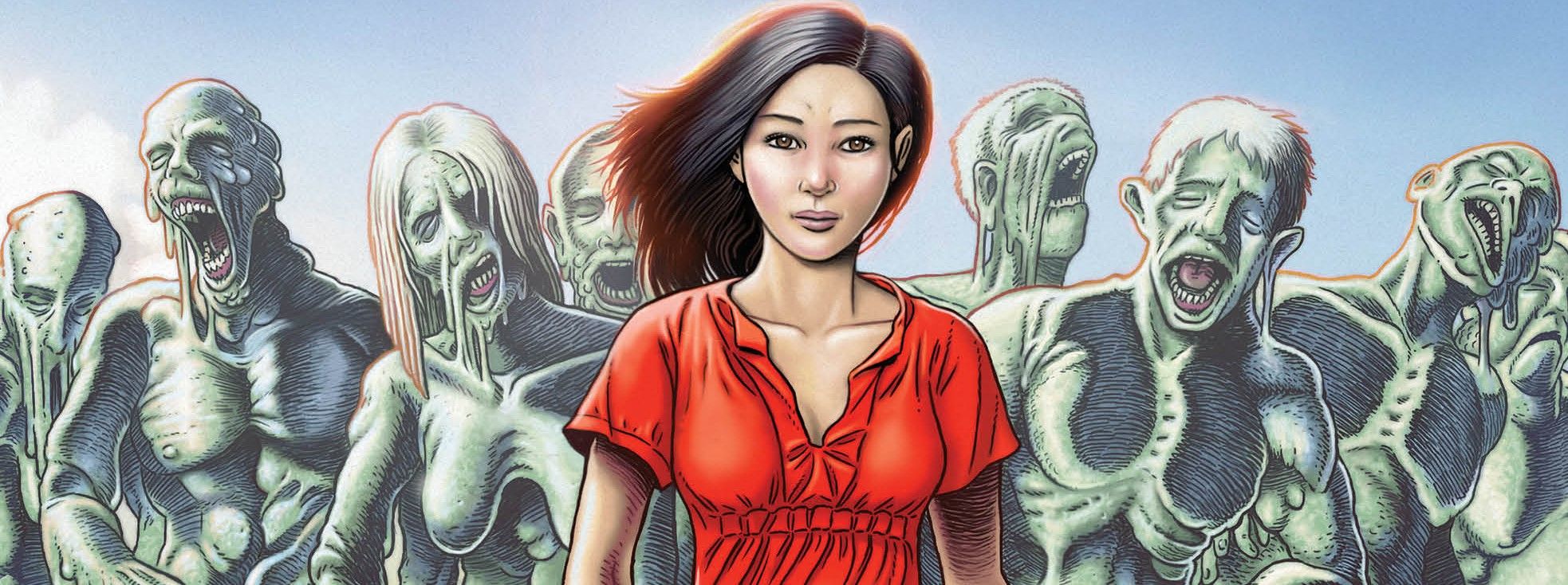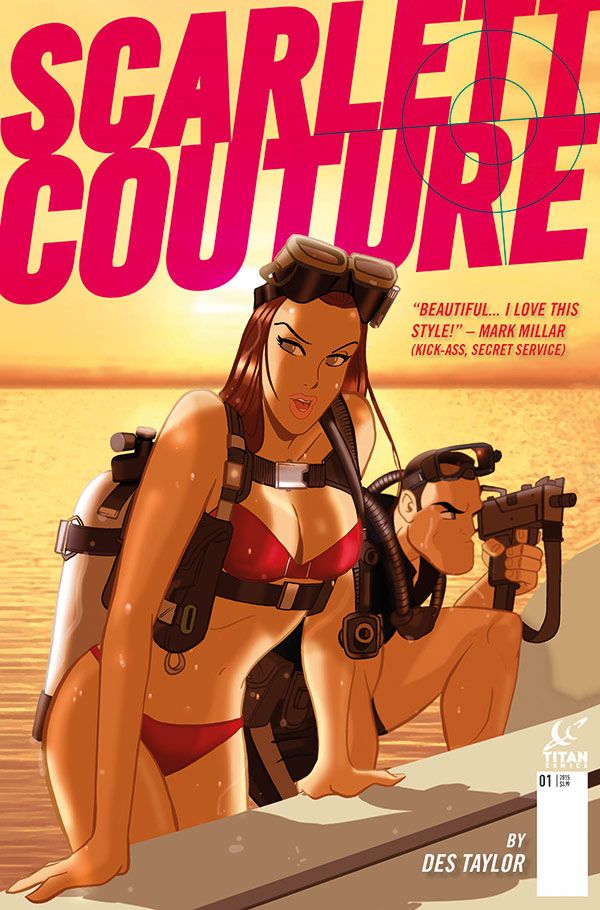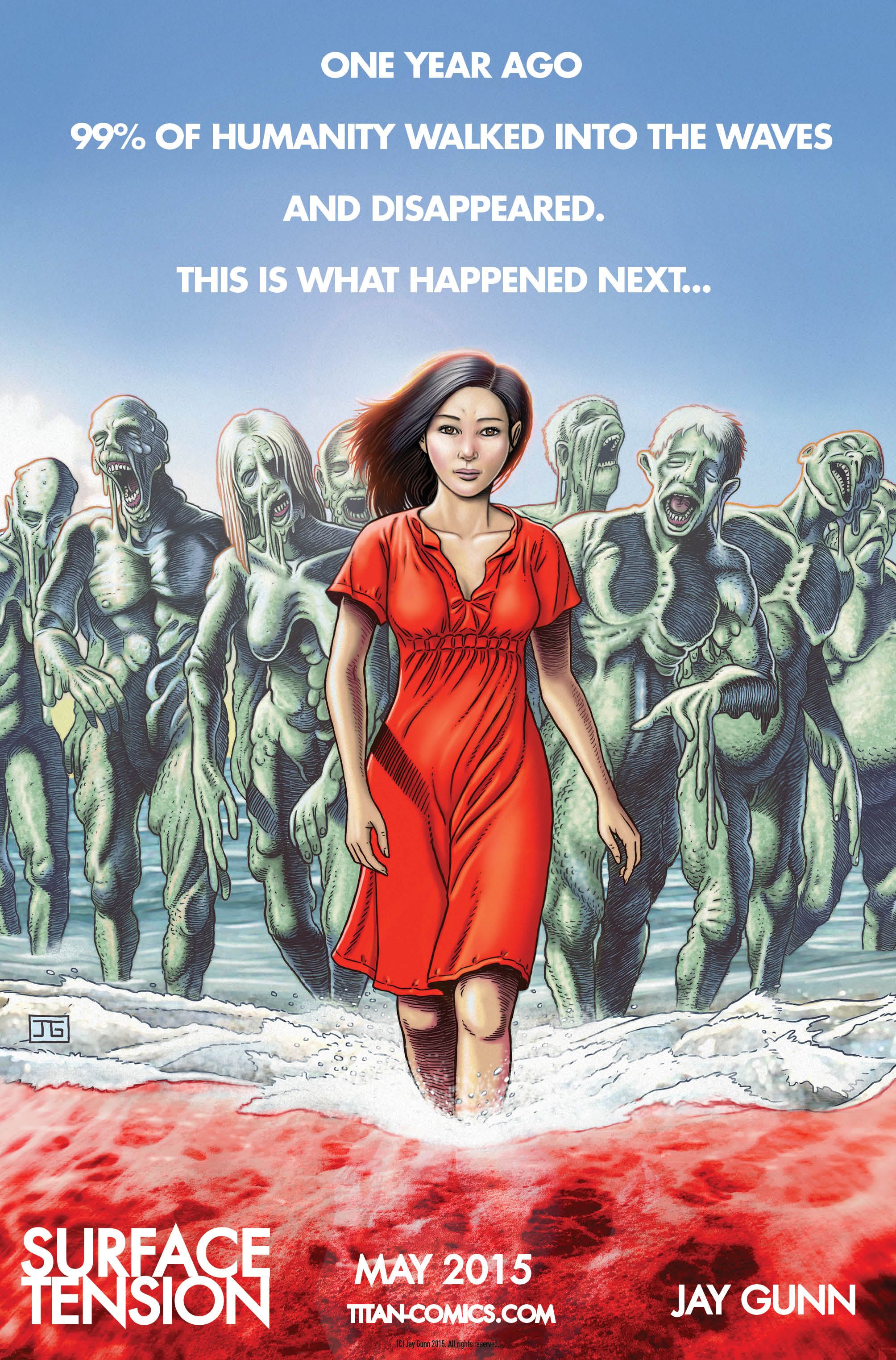"I'm a model, you know what I mean, and I do my little turn on the catwalk"
When I took a look at the latest Previews, I mentioned that Titan Comics was offering Scarlett Couture, which is a world of fashion-meets-world of espionage mash-up courtesy of Des Taylor, who knows a thing or two about fashion. The Marketing Manager at Titan saw my post and contacted me about reviewing the first issue of the series before the order cut-off dates, in case anyone was interested in checking it out. He also sent me Surface Tension, which will be in next month's Previews. So I read both digital copies, and I have some thoughts about them!
Before I get to Scarlett Couture, I have to point out that I have met Taylor (a few years ago, at San Diego), and that he is a tremendously cool dude. He's very positive and he loves talking and he really digs comics. I'm always wary about reviewing something by people I like - even if I've only met them briefly - so I try to get that out of the way. I doubt if he remembers me, but I remember him, and I'm the one writing the post, after all. So you can always take what I write with a grain of salt - I try not to let my personal feelings get in the way of my reviews, but can we really do that completely? CAN WE?!?!?!?
So, Scarlett Couture. The set-up is simple: Scarlett is the daughter of a woman who runs a top fashion house, and she provides security for that firm. She also happens to work for the CIA, as did her mother. The theory is, as Taylor writes in the backmatter, that models would make perfect agents - they have access to everything because everyone always lets beautiful women go anywhere they want, and no one would suspect them. So he created Scarlett. And she's on a mission!
The first issue begins in media res, which is a good thing as we don't need a lot of set-up, and Taylor provides it as he goes along, teasing some things and explaining others (he provides "dossiers and mission logs" at the end of the issue to fill in some blanks, which is nice but actually somewhat unnecessary). Taylor is a better artist than writer, and that's clear from this first issue. Every page is full of spy-fiction clichés, which isn't too surprising but is still somewhat disappointing. A man holds a model hostage because he wants to know who "Valerie Rosario" - who turns out to be another CIA agent/supermodel - works for. When the woman says she doesn't know, the bad guy - his name's "Covan" - says, "Now, I'd be lying if I said you'll make it out of here alive tonight, but that doesn't mean we can't be friends. Just tell me what I need to know, and I promise I'll leave the knife till last." Standard bad-guy talk, in other words. A news report supplies some background, and then we meet Scarlett, who has of course gone into the bad guys' lair without back-up, because she's a loose cannon. Her mentor, Clifton Kelly (I seriously hope Taylor was thinking of this guy when he named him), is yelling at her on the phone, but Scarlett ignores him. She takes out a bunch of bad guys and rescues one young lady (not the one in the beginning) before her back-up arrives, and then she tries to track down Covan but finds ... more than she bargained for! At the end of the issue, we get a glimpse of the bad guys, and if you thought they might be a vague foreign type, an evil businessman, and a corrupt government agent ... well, congratulations - you've consumed action/adventure fiction in the past.
The problem with using so many clichés (not just the characters, but the dialogue as well - Covan's threat isn't the only place we get it) is that it undermines the story itself. The idea of models as secret agents is a good one, mainly because Taylor is right - they can get into places that mere mortals can't (like "the forbidden city" in Seinfeld), and they probably do get underestimated because everyone thinks they're ornamental. He wants to kick-start the story, so he ignores that concept for the most part and just gives us an ass-kicking young lady who charges into situations without care for her own personal safety, which is a heroic trope as old as the hills. It's not a bad way to start the series, mind you, but it is only four issues long, so I hope that Taylor can get more to the idea of models as secret agents and maybe give us more spy stuff and less ass-kicking. Yes, everyone loves a good ass-kicking, but it's spread a bit thick in issue #1. There's no chance that Scarlett is even going to get a little hurt, so we only need to see a little of her doing her thing to establish her credentials. Obviously, Taylor has thought quite a bit about this, so I assume (hope?) that he does want to examine that dichotomy between the way people view models and the way models could make that work for them, which is why I'm not willing to give up on the story yet. Of course, just as I long ago drifted away from superhero comics (not completely, of course, but to a large degree), I'm not as interested in straight-up action/adventure anymore. I still like it, but I crave something deeper.
Part of the reason I do enjoy the issue to a certain point is that Taylor's art remains wonderful. He has a beautiful, stylish line that fits really well with both the world of fashion and the world of fictionalized spycraft (I imagine actual spycraft is much dirtier and messier). His clean style isn't the best fit for some of the uglier aspects of the book, but that's a mild complaint, especially as everything else is so good. His women are beautiful, naturally, but they're also realistic, as Taylor makes sure to draw them proportionately and wearing sensible clothing. His action scenes are well choreographed and move very nicely - his figures are fluid and never look posed as they fight, which is nice. Taylor is quite good at facial expressions, as we're able to read Scarlett's reactions as she's fighting the bad guys very well (which makes some of the narration superfluous - Taylor the writer doesn't quite trust Taylor the artist yet, although he should) and the main thug - Covan - is delightfully insane. Taylor's style is fairly slick, so the computer effects he uses blend in very well with the figures. As you might recall, I don't love computer effects, but some artists use them better than others. Taylor knows what he's doing with them, and his style suits them, so it works quite well. Taylor's colors are nice and bright, too, even when Scarlett is fighting in a darkened warehouse. Taylor wants you to see everything, man!
While I don't love Scarlett Couture #1, it's entertaining and looks great. It's one of those books that I want to like more than I do, and because I'm a fan of Taylor's art, I'm going to get the entire series. I do hope the story gets a bit better, though.
Rating: ★ ★ ★ ★ ★ ★ ☆ ☆ ☆ ☆
Surface Tension is by Jay Gunn (with letters by Jimmy Betancourt and Albert Deschesne), and the first issue is a good, hefty chunk of comics - who doesn't love more comics for your buck? The premise of the book is that a year ago, almost the entire population of the Earth started to melt - their flesh began to turn into water, which makes for a charming visual (as you can see above). They all headed for the oceans and disappeared. Meanwhile, some strange coral formations sprang up and several new, odd species of creatures starting venturing out of the seas. Now, on one of the Channel Islands (the ones in the English Channel, not the ones by Los Angeles), two people who went into the water have returned. WHAT CAN IT MEAN?!?!?!?
Gunn does a very nice job setting up the premise, as we begin with a teenager (or possibly a young lady in her early 20s) named Shauna, hanging out on the beach of Breith (a fictional Channel island) with a younger girl named Asha, where she discovers the two people who came out of the water. The man is Ryan, who was Shauna's boyfriend a year earlier (the fact that Gunn sets this on a small island makes it easier to deal with that coincidence), while the woman is Megumi, a scientist who had been studying the environment and had been on the island for some reason (we don't know what it is yet). The authorities quarantine them - the "sea-sickness" that affected everyone in the world doesn't seem to be contagious, but you never know (Ryan's and Megumi's skin is now blue, for instance) - and Megumi asks to speak to an older woman, Mary, whom she had helped get away from the mass of humanity moving toward the ocean a year earlier. When Mary and Megumi talk, we get a lot of the backstory about the coral and some of what's going on. Gunn is telling an ecological warning story, but it never comes across as polemical. The coral seems to be both benign and somehow malicious, and presumably the rest of the story will be about figuring out what exactly it's doing. Gunn tells the story in a straight-forward way - we get the initial inciting event, complete with some indications about the new species of sea life, some of which is friendly and some of which is definitely not. Then we get an extended flashback in which Megumi explains things to Mary, which seems a bit too convenient given that both Ryan and Megumi claim to have lost their memory (Gunn does make some attempts to show that Megumi is struggling to recall all the events that happened). Megumi's story is interesting - her boyfriend, Erik, discovered the coral and that it seemed to be cleaning the ocean, but what happens after that makes the coral's motives a bit more suspect.
Gunn doesn't do too much to give the characters much personality (well, artistically he does, but not through their dialogue), but that's okay - so much of this issue sets up the main plot, so the other things he hints at, such as Shauna and Ryan's still-existent attraction, the religion that has sprung up about the sea and its creatures, the fact that Shauna appears to have a new boyfriend, and the problems of simply living on the island (the sea monsters don't let the people leave, so it's difficult for them to be self-sustaining), are brought up but not explored too much. The hints are pretty good, though, showing us a fully-realized semi-post-apocalyptic world and the disparate people who live in it. The mystery is perfectly fine, but it's also nice that it can take place in a world that has a lot of familiar elements even if it's so unusual on the surface.
The art is quite nice, too. Gunn has a bit of a Bryan Talbot vibe going on, and he brings the world he's created to life quite nicely. His details are really impressive, as he makes Breith a beautiful and friendly place even as the strange things keep happening. The coral tower off the coast is an eerie and menacing presence, intruding on the idyllic landscape in several panels, which is quite neat. When he gets to the flashback with Erik discovering the coral formation, he does a wonderful job with the twisted details of the coral and what it does to Erik. He has a sharp, clean line that makes the strange horror of the melting flesh of the affected more disturbing, as we can see every small detail, which also makes Erik's fate more terrifying. It also makes his sea creatures that much stranger - at the end, the creature that attacks some islanders is wonderfully crisp, with creepy crabs stuck all over its body and lush grass growing out of its back. Gunn's people are nicely done, too. Erik's slow descent into madness is not done through his words (although they're a bit kooky, they're not too bad), as Gunn shows his eyes and face slowly changing into something not quite normal. Each character has their own personality, from Cassel's hard-bitten pragmatism to Mary's kindly understanding. Gunn is equally at ease with the horrible and the mundane, which helps the book feel more realistic. The book is colored beautifully, too, with brightness infusing every page. Gunn makes Breith, with its narrow streets and buildings and lush farmland, look almost like a paradise, which helps contrast it with the monsters lurking off shore, and while he does create some dark creatures, the coloring is never drab and dull. It's a terrific-looking comic.
Gunn does a better job at setting up the premise than Taylor does on Scarlett Couture, so while the former book is a bit more action-packed, Surface Tension is more involved and interesting. Obviously, Gunn's book is a bit more thoughtful while Taylor's is more of a romp, but Gunn's book is longer, which helps a lot (first issues should always be a bit longer, in my humble opinion, because there's so much a creator needs to get to). The nice thing about Gunn's book is that he couches real concerns - the environment is a pretty big deal - in a mystery/horror/science fiction story, and he does it well. So there's that.
I'll note when Surface Tension shows up in Previews, but you should keep an eye out for it. It's pretty keen.
Rating: ★ ★ ★ ★ ★ ★ ★ ½ ☆ ☆
Titan has been doing some nice work with their output, and these two books are fine additions to their library. Let's hope they both get even better with their second issues!



